Massive MIMO for Network Access
VerifiedAdded on 2023/03/20
|9
|3986
|89
AI Summary
This document explores the applications of Massive MIMO in heterogeneous networks and its impact on network access. It discusses propagation channels, beamforming, and random access protocols. The article also provides insights into recent research on Massive MIMO propagation channels and hybrid beamforming.
Contribute Materials
Your contribution can guide someone’s learning journey. Share your
documents today.
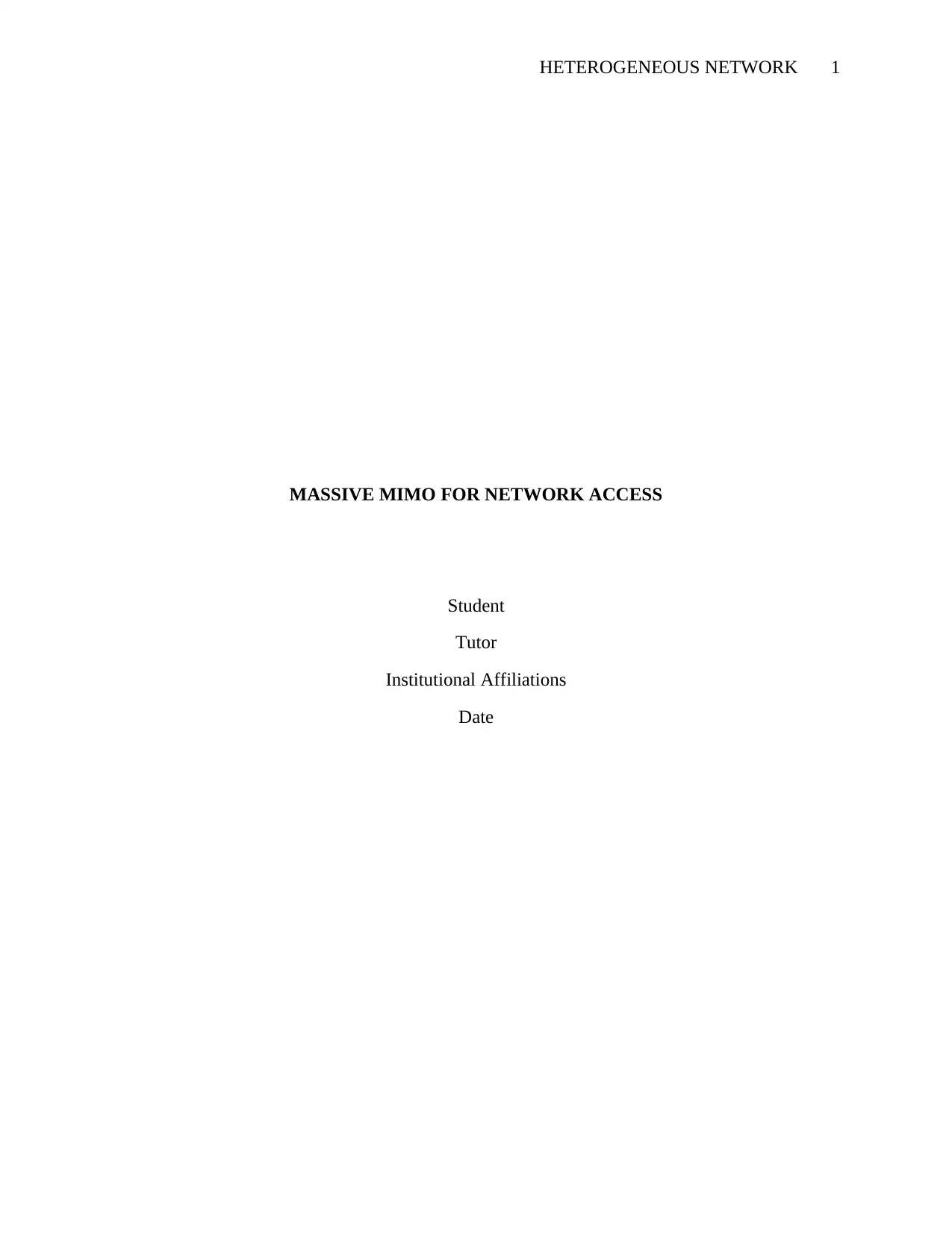
HETEROGENEOUS NETWORK 1
MASSIVE MIMO FOR NETWORK ACCESS
Student
Tutor
Institutional Affiliations
Date
MASSIVE MIMO FOR NETWORK ACCESS
Student
Tutor
Institutional Affiliations
Date
Secure Best Marks with AI Grader
Need help grading? Try our AI Grader for instant feedback on your assignments.
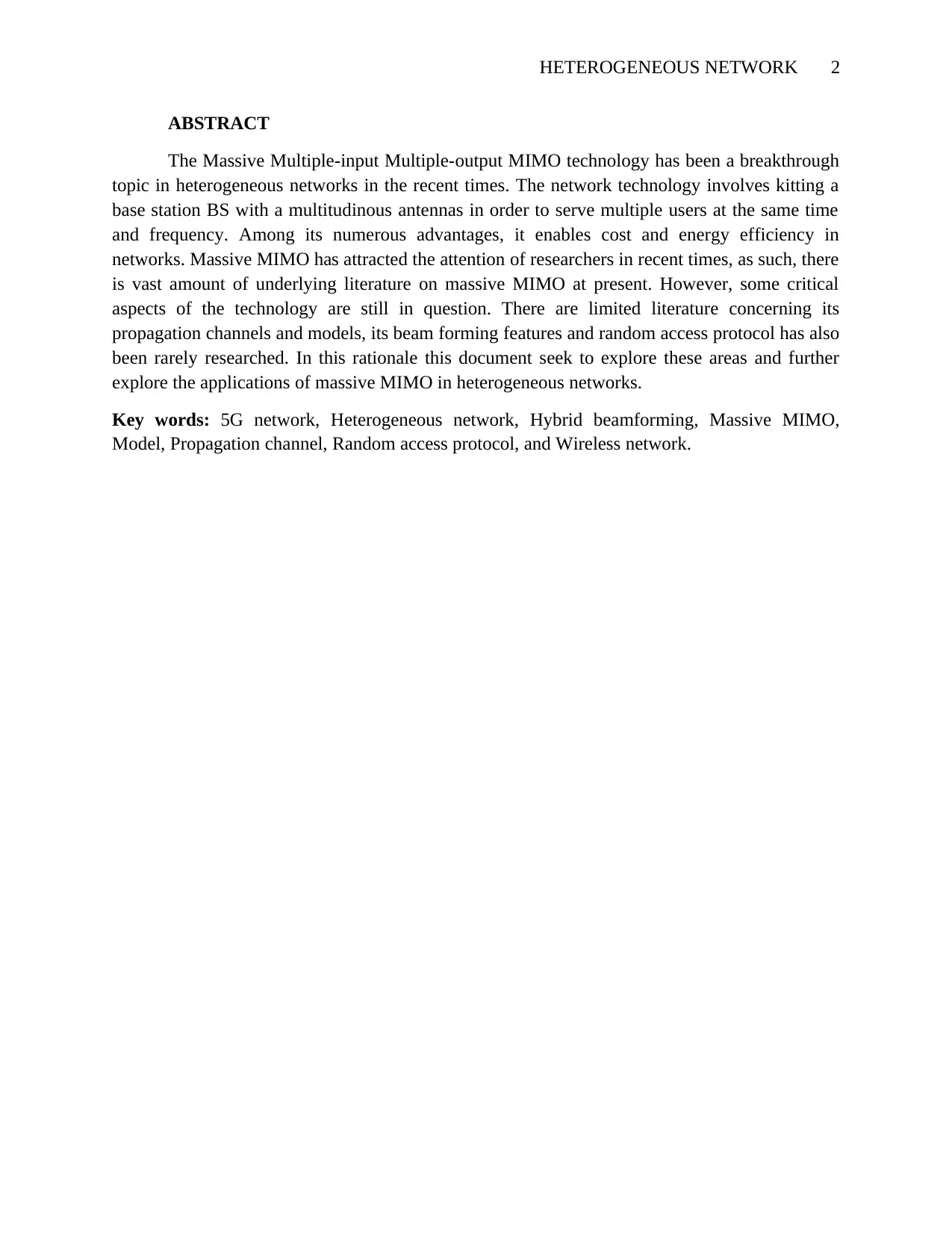
HETEROGENEOUS NETWORK 2
ABSTRACT
The Massive Multiple-input Multiple-output MIMO technology has been a breakthrough
topic in heterogeneous networks in the recent times. The network technology involves kitting a
base station BS with a multitudinous antennas in order to serve multiple users at the same time
and frequency. Among its numerous advantages, it enables cost and energy efficiency in
networks. Massive MIMO has attracted the attention of researchers in recent times, as such, there
is vast amount of underlying literature on massive MIMO at present. However, some critical
aspects of the technology are still in question. There are limited literature concerning its
propagation channels and models, its beam forming features and random access protocol has also
been rarely researched. In this rationale this document seek to explore these areas and further
explore the applications of massive MIMO in heterogeneous networks.
Key words: 5G network, Heterogeneous network, Hybrid beamforming, Massive MIMO,
Model, Propagation channel, Random access protocol, and Wireless network.
ABSTRACT
The Massive Multiple-input Multiple-output MIMO technology has been a breakthrough
topic in heterogeneous networks in the recent times. The network technology involves kitting a
base station BS with a multitudinous antennas in order to serve multiple users at the same time
and frequency. Among its numerous advantages, it enables cost and energy efficiency in
networks. Massive MIMO has attracted the attention of researchers in recent times, as such, there
is vast amount of underlying literature on massive MIMO at present. However, some critical
aspects of the technology are still in question. There are limited literature concerning its
propagation channels and models, its beam forming features and random access protocol has also
been rarely researched. In this rationale this document seek to explore these areas and further
explore the applications of massive MIMO in heterogeneous networks.
Key words: 5G network, Heterogeneous network, Hybrid beamforming, Massive MIMO,
Model, Propagation channel, Random access protocol, and Wireless network.
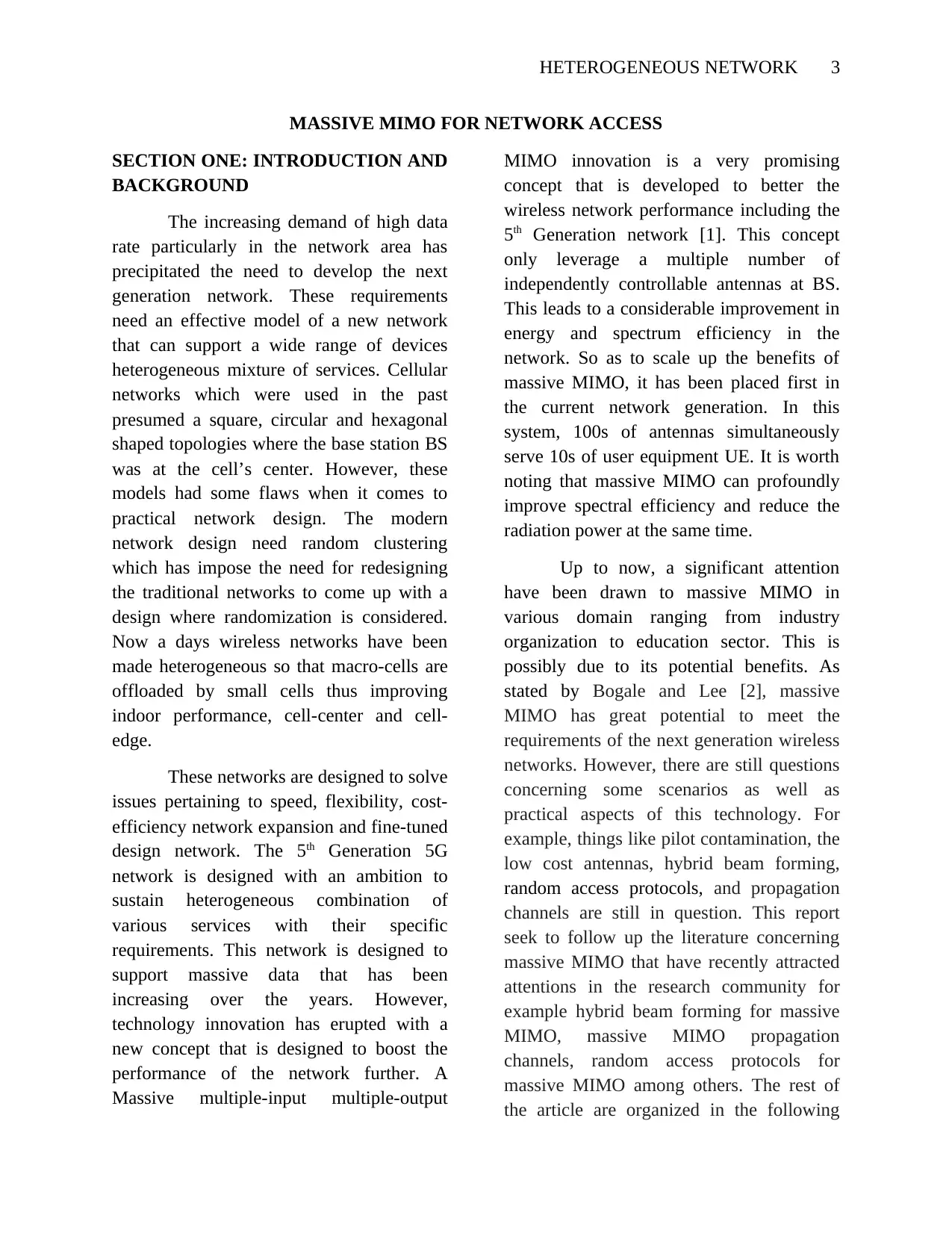
HETEROGENEOUS NETWORK 3
MASSIVE MIMO FOR NETWORK ACCESS
SECTION ONE: INTRODUCTION AND
BACKGROUND
The increasing demand of high data
rate particularly in the network area has
precipitated the need to develop the next
generation network. These requirements
need an effective model of a new network
that can support a wide range of devices
heterogeneous mixture of services. Cellular
networks which were used in the past
presumed a square, circular and hexagonal
shaped topologies where the base station BS
was at the cell’s center. However, these
models had some flaws when it comes to
practical network design. The modern
network design need random clustering
which has impose the need for redesigning
the traditional networks to come up with a
design where randomization is considered.
Now a days wireless networks have been
made heterogeneous so that macro-cells are
offloaded by small cells thus improving
indoor performance, cell-center and cell-
edge.
These networks are designed to solve
issues pertaining to speed, flexibility, cost-
efficiency network expansion and fine-tuned
design network. The 5th Generation 5G
network is designed with an ambition to
sustain heterogeneous combination of
various services with their specific
requirements. This network is designed to
support massive data that has been
increasing over the years. However,
technology innovation has erupted with a
new concept that is designed to boost the
performance of the network further. A
Massive multiple-input multiple-output
MIMO innovation is a very promising
concept that is developed to better the
wireless network performance including the
5th Generation network [1]. This concept
only leverage a multiple number of
independently controllable antennas at BS.
This leads to a considerable improvement in
energy and spectrum efficiency in the
network. So as to scale up the benefits of
massive MIMO, it has been placed first in
the current network generation. In this
system, 100s of antennas simultaneously
serve 10s of user equipment UE. It is worth
noting that massive MIMO can profoundly
improve spectral efficiency and reduce the
radiation power at the same time.
Up to now, a significant attention
have been drawn to massive MIMO in
various domain ranging from industry
organization to education sector. This is
possibly due to its potential benefits. As
stated by Bogale and Lee [2], massive
MIMO has great potential to meet the
requirements of the next generation wireless
networks. However, there are still questions
concerning some scenarios as well as
practical aspects of this technology. For
example, things like pilot contamination, the
low cost antennas, hybrid beam forming,
random access protocols, and propagation
channels are still in question. This report
seek to follow up the literature concerning
massive MIMO that have recently attracted
attentions in the research community for
example hybrid beam forming for massive
MIMO, massive MIMO propagation
channels, random access protocols for
massive MIMO among others. The rest of
the article are organized in the following
MASSIVE MIMO FOR NETWORK ACCESS
SECTION ONE: INTRODUCTION AND
BACKGROUND
The increasing demand of high data
rate particularly in the network area has
precipitated the need to develop the next
generation network. These requirements
need an effective model of a new network
that can support a wide range of devices
heterogeneous mixture of services. Cellular
networks which were used in the past
presumed a square, circular and hexagonal
shaped topologies where the base station BS
was at the cell’s center. However, these
models had some flaws when it comes to
practical network design. The modern
network design need random clustering
which has impose the need for redesigning
the traditional networks to come up with a
design where randomization is considered.
Now a days wireless networks have been
made heterogeneous so that macro-cells are
offloaded by small cells thus improving
indoor performance, cell-center and cell-
edge.
These networks are designed to solve
issues pertaining to speed, flexibility, cost-
efficiency network expansion and fine-tuned
design network. The 5th Generation 5G
network is designed with an ambition to
sustain heterogeneous combination of
various services with their specific
requirements. This network is designed to
support massive data that has been
increasing over the years. However,
technology innovation has erupted with a
new concept that is designed to boost the
performance of the network further. A
Massive multiple-input multiple-output
MIMO innovation is a very promising
concept that is developed to better the
wireless network performance including the
5th Generation network [1]. This concept
only leverage a multiple number of
independently controllable antennas at BS.
This leads to a considerable improvement in
energy and spectrum efficiency in the
network. So as to scale up the benefits of
massive MIMO, it has been placed first in
the current network generation. In this
system, 100s of antennas simultaneously
serve 10s of user equipment UE. It is worth
noting that massive MIMO can profoundly
improve spectral efficiency and reduce the
radiation power at the same time.
Up to now, a significant attention
have been drawn to massive MIMO in
various domain ranging from industry
organization to education sector. This is
possibly due to its potential benefits. As
stated by Bogale and Lee [2], massive
MIMO has great potential to meet the
requirements of the next generation wireless
networks. However, there are still questions
concerning some scenarios as well as
practical aspects of this technology. For
example, things like pilot contamination, the
low cost antennas, hybrid beam forming,
random access protocols, and propagation
channels are still in question. This report
seek to follow up the literature concerning
massive MIMO that have recently attracted
attentions in the research community for
example hybrid beam forming for massive
MIMO, massive MIMO propagation
channels, random access protocols for
massive MIMO among others. The rest of
the article are organized in the following
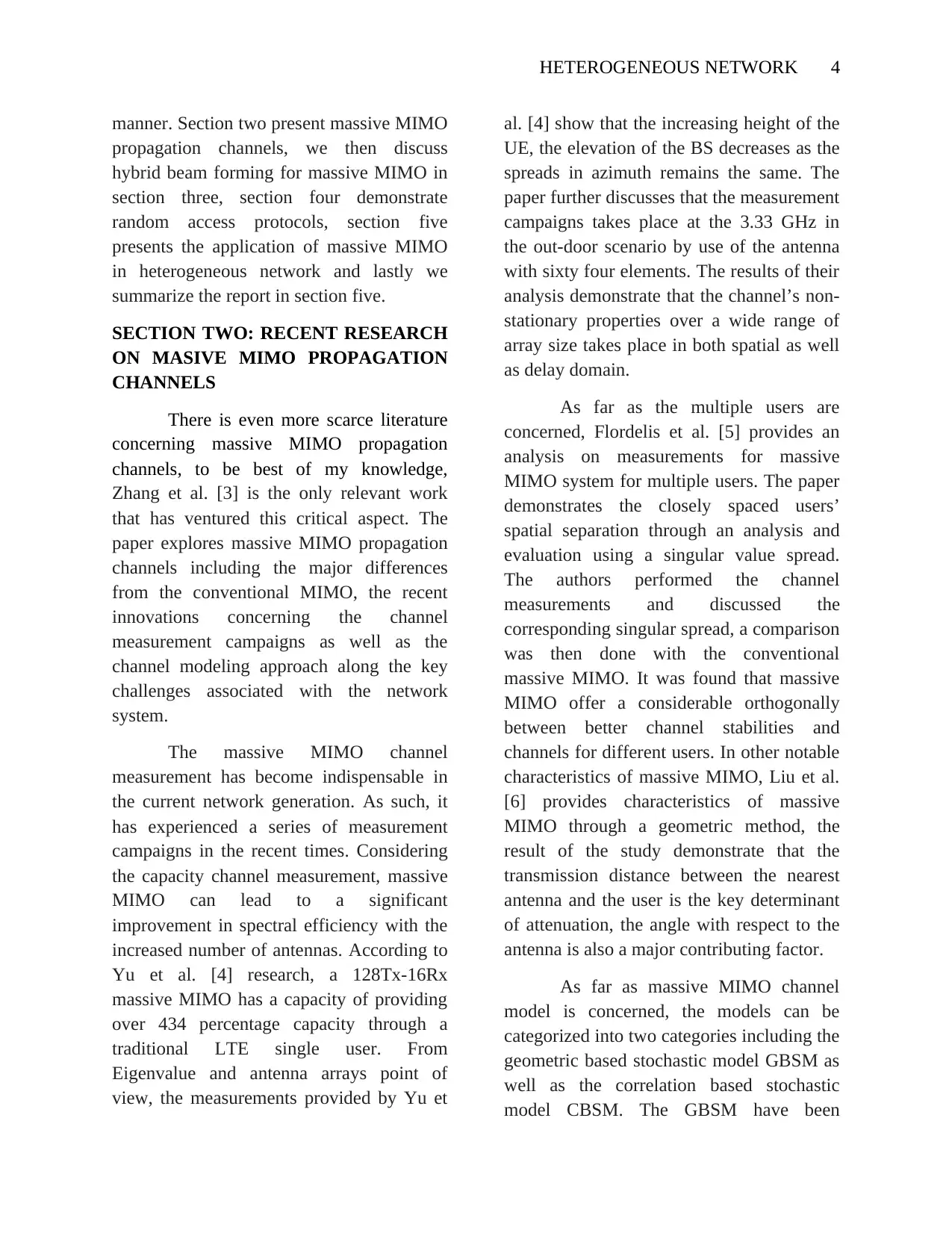
HETEROGENEOUS NETWORK 4
manner. Section two present massive MIMO
propagation channels, we then discuss
hybrid beam forming for massive MIMO in
section three, section four demonstrate
random access protocols, section five
presents the application of massive MIMO
in heterogeneous network and lastly we
summarize the report in section five.
SECTION TWO: RECENT RESEARCH
ON MASIVE MIMO PROPAGATION
CHANNELS
There is even more scarce literature
concerning massive MIMO propagation
channels, to be best of my knowledge,
Zhang et al. [3] is the only relevant work
that has ventured this critical aspect. The
paper explores massive MIMO propagation
channels including the major differences
from the conventional MIMO, the recent
innovations concerning the channel
measurement campaigns as well as the
channel modeling approach along the key
challenges associated with the network
system.
The massive MIMO channel
measurement has become indispensable in
the current network generation. As such, it
has experienced a series of measurement
campaigns in the recent times. Considering
the capacity channel measurement, massive
MIMO can lead to a significant
improvement in spectral efficiency with the
increased number of antennas. According to
Yu et al. [4] research, a 128Tx-16Rx
massive MIMO has a capacity of providing
over 434 percentage capacity through a
traditional LTE single user. From
Eigenvalue and antenna arrays point of
view, the measurements provided by Yu et
al. [4] show that the increasing height of the
UE, the elevation of the BS decreases as the
spreads in azimuth remains the same. The
paper further discusses that the measurement
campaigns takes place at the 3.33 GHz in
the out-door scenario by use of the antenna
with sixty four elements. The results of their
analysis demonstrate that the channel’s non-
stationary properties over a wide range of
array size takes place in both spatial as well
as delay domain.
As far as the multiple users are
concerned, Flordelis et al. [5] provides an
analysis on measurements for massive
MIMO system for multiple users. The paper
demonstrates the closely spaced users’
spatial separation through an analysis and
evaluation using a singular value spread.
The authors performed the channel
measurements and discussed the
corresponding singular spread, a comparison
was then done with the conventional
massive MIMO. It was found that massive
MIMO offer a considerable orthogonally
between better channel stabilities and
channels for different users. In other notable
characteristics of massive MIMO, Liu et al.
[6] provides characteristics of massive
MIMO through a geometric method, the
result of the study demonstrate that the
transmission distance between the nearest
antenna and the user is the key determinant
of attenuation, the angle with respect to the
antenna is also a major contributing factor.
As far as massive MIMO channel
model is concerned, the models can be
categorized into two categories including the
geometric based stochastic model GBSM as
well as the correlation based stochastic
model CBSM. The GBSM have been
manner. Section two present massive MIMO
propagation channels, we then discuss
hybrid beam forming for massive MIMO in
section three, section four demonstrate
random access protocols, section five
presents the application of massive MIMO
in heterogeneous network and lastly we
summarize the report in section five.
SECTION TWO: RECENT RESEARCH
ON MASIVE MIMO PROPAGATION
CHANNELS
There is even more scarce literature
concerning massive MIMO propagation
channels, to be best of my knowledge,
Zhang et al. [3] is the only relevant work
that has ventured this critical aspect. The
paper explores massive MIMO propagation
channels including the major differences
from the conventional MIMO, the recent
innovations concerning the channel
measurement campaigns as well as the
channel modeling approach along the key
challenges associated with the network
system.
The massive MIMO channel
measurement has become indispensable in
the current network generation. As such, it
has experienced a series of measurement
campaigns in the recent times. Considering
the capacity channel measurement, massive
MIMO can lead to a significant
improvement in spectral efficiency with the
increased number of antennas. According to
Yu et al. [4] research, a 128Tx-16Rx
massive MIMO has a capacity of providing
over 434 percentage capacity through a
traditional LTE single user. From
Eigenvalue and antenna arrays point of
view, the measurements provided by Yu et
al. [4] show that the increasing height of the
UE, the elevation of the BS decreases as the
spreads in azimuth remains the same. The
paper further discusses that the measurement
campaigns takes place at the 3.33 GHz in
the out-door scenario by use of the antenna
with sixty four elements. The results of their
analysis demonstrate that the channel’s non-
stationary properties over a wide range of
array size takes place in both spatial as well
as delay domain.
As far as the multiple users are
concerned, Flordelis et al. [5] provides an
analysis on measurements for massive
MIMO system for multiple users. The paper
demonstrates the closely spaced users’
spatial separation through an analysis and
evaluation using a singular value spread.
The authors performed the channel
measurements and discussed the
corresponding singular spread, a comparison
was then done with the conventional
massive MIMO. It was found that massive
MIMO offer a considerable orthogonally
between better channel stabilities and
channels for different users. In other notable
characteristics of massive MIMO, Liu et al.
[6] provides characteristics of massive
MIMO through a geometric method, the
result of the study demonstrate that the
transmission distance between the nearest
antenna and the user is the key determinant
of attenuation, the angle with respect to the
antenna is also a major contributing factor.
As far as massive MIMO channel
model is concerned, the models can be
categorized into two categories including the
geometric based stochastic model GBSM as
well as the correlation based stochastic
model CBSM. The GBSM have been
Secure Best Marks with AI Grader
Need help grading? Try our AI Grader for instant feedback on your assignments.
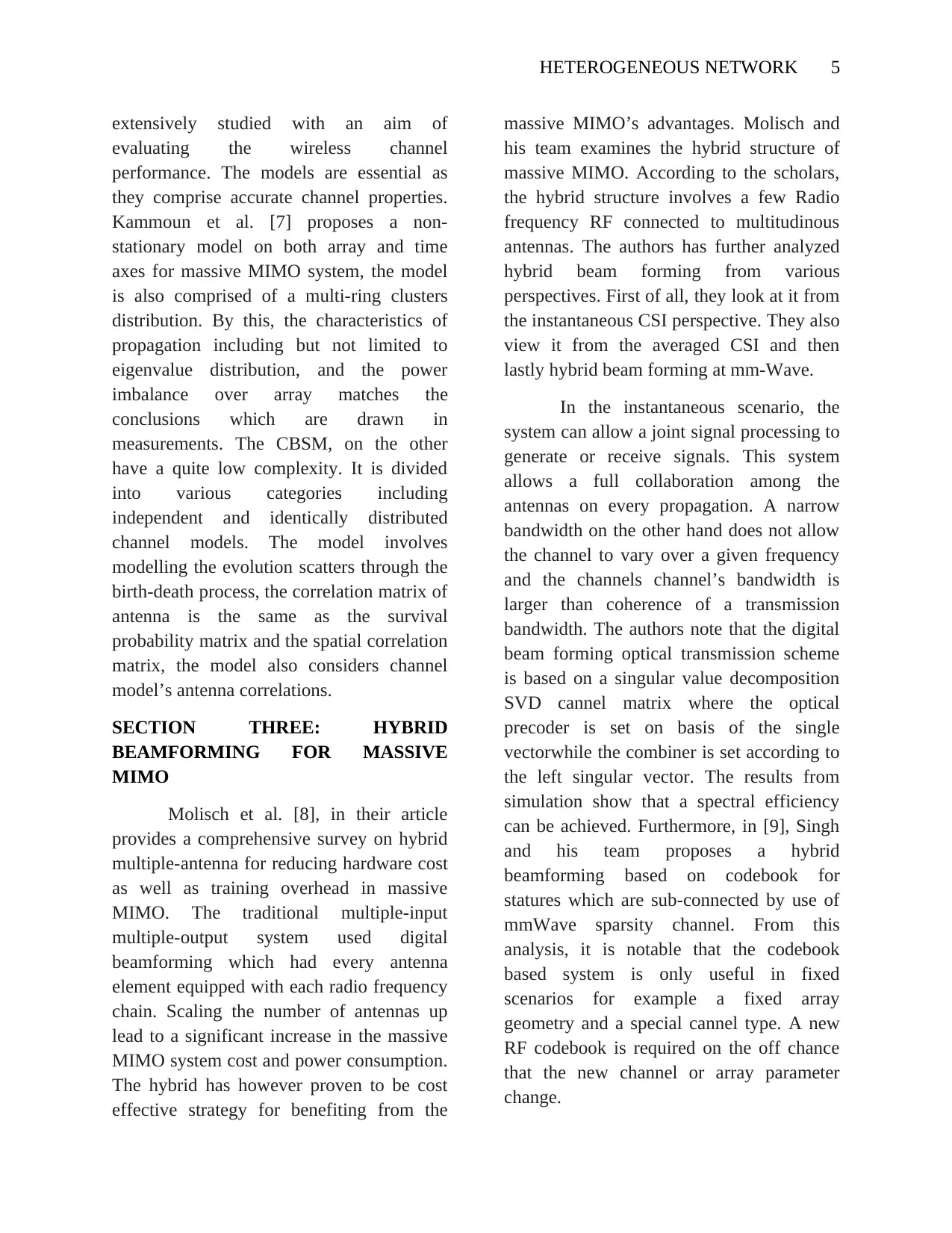
HETEROGENEOUS NETWORK 5
extensively studied with an aim of
evaluating the wireless channel
performance. The models are essential as
they comprise accurate channel properties.
Kammoun et al. [7] proposes a non-
stationary model on both array and time
axes for massive MIMO system, the model
is also comprised of a multi-ring clusters
distribution. By this, the characteristics of
propagation including but not limited to
eigenvalue distribution, and the power
imbalance over array matches the
conclusions which are drawn in
measurements. The CBSM, on the other
have a quite low complexity. It is divided
into various categories including
independent and identically distributed
channel models. The model involves
modelling the evolution scatters through the
birth-death process, the correlation matrix of
antenna is the same as the survival
probability matrix and the spatial correlation
matrix, the model also considers channel
model’s antenna correlations.
SECTION THREE: HYBRID
BEAMFORMING FOR MASSIVE
MIMO
Molisch et al. [8], in their article
provides a comprehensive survey on hybrid
multiple-antenna for reducing hardware cost
as well as training overhead in massive
MIMO. The traditional multiple-input
multiple-output system used digital
beamforming which had every antenna
element equipped with each radio frequency
chain. Scaling the number of antennas up
lead to a significant increase in the massive
MIMO system cost and power consumption.
The hybrid has however proven to be cost
effective strategy for benefiting from the
massive MIMO’s advantages. Molisch and
his team examines the hybrid structure of
massive MIMO. According to the scholars,
the hybrid structure involves a few Radio
frequency RF connected to multitudinous
antennas. The authors has further analyzed
hybrid beam forming from various
perspectives. First of all, they look at it from
the instantaneous CSI perspective. They also
view it from the averaged CSI and then
lastly hybrid beam forming at mm-Wave.
In the instantaneous scenario, the
system can allow a joint signal processing to
generate or receive signals. This system
allows a full collaboration among the
antennas on every propagation. A narrow
bandwidth on the other hand does not allow
the channel to vary over a given frequency
and the channels channel’s bandwidth is
larger than coherence of a transmission
bandwidth. The authors note that the digital
beam forming optical transmission scheme
is based on a singular value decomposition
SVD cannel matrix where the optical
precoder is set on basis of the single
vectorwhile the combiner is set according to
the left singular vector. The results from
simulation show that a spectral efficiency
can be achieved. Furthermore, in [9], Singh
and his team proposes a hybrid
beamforming based on codebook for
statures which are sub-connected by use of
mmWave sparsity channel. From this
analysis, it is notable that the codebook
based system is only useful in fixed
scenarios for example a fixed array
geometry and a special cannel type. A new
RF codebook is required on the off chance
that the new channel or array parameter
change.
extensively studied with an aim of
evaluating the wireless channel
performance. The models are essential as
they comprise accurate channel properties.
Kammoun et al. [7] proposes a non-
stationary model on both array and time
axes for massive MIMO system, the model
is also comprised of a multi-ring clusters
distribution. By this, the characteristics of
propagation including but not limited to
eigenvalue distribution, and the power
imbalance over array matches the
conclusions which are drawn in
measurements. The CBSM, on the other
have a quite low complexity. It is divided
into various categories including
independent and identically distributed
channel models. The model involves
modelling the evolution scatters through the
birth-death process, the correlation matrix of
antenna is the same as the survival
probability matrix and the spatial correlation
matrix, the model also considers channel
model’s antenna correlations.
SECTION THREE: HYBRID
BEAMFORMING FOR MASSIVE
MIMO
Molisch et al. [8], in their article
provides a comprehensive survey on hybrid
multiple-antenna for reducing hardware cost
as well as training overhead in massive
MIMO. The traditional multiple-input
multiple-output system used digital
beamforming which had every antenna
element equipped with each radio frequency
chain. Scaling the number of antennas up
lead to a significant increase in the massive
MIMO system cost and power consumption.
The hybrid has however proven to be cost
effective strategy for benefiting from the
massive MIMO’s advantages. Molisch and
his team examines the hybrid structure of
massive MIMO. According to the scholars,
the hybrid structure involves a few Radio
frequency RF connected to multitudinous
antennas. The authors has further analyzed
hybrid beam forming from various
perspectives. First of all, they look at it from
the instantaneous CSI perspective. They also
view it from the averaged CSI and then
lastly hybrid beam forming at mm-Wave.
In the instantaneous scenario, the
system can allow a joint signal processing to
generate or receive signals. This system
allows a full collaboration among the
antennas on every propagation. A narrow
bandwidth on the other hand does not allow
the channel to vary over a given frequency
and the channels channel’s bandwidth is
larger than coherence of a transmission
bandwidth. The authors note that the digital
beam forming optical transmission scheme
is based on a singular value decomposition
SVD cannel matrix where the optical
precoder is set on basis of the single
vectorwhile the combiner is set according to
the left singular vector. The results from
simulation show that a spectral efficiency
can be achieved. Furthermore, in [9], Singh
and his team proposes a hybrid
beamforming based on codebook for
statures which are sub-connected by use of
mmWave sparsity channel. From this
analysis, it is notable that the codebook
based system is only useful in fixed
scenarios for example a fixed array
geometry and a special cannel type. A new
RF codebook is required on the off chance
that the new channel or array parameter
change.
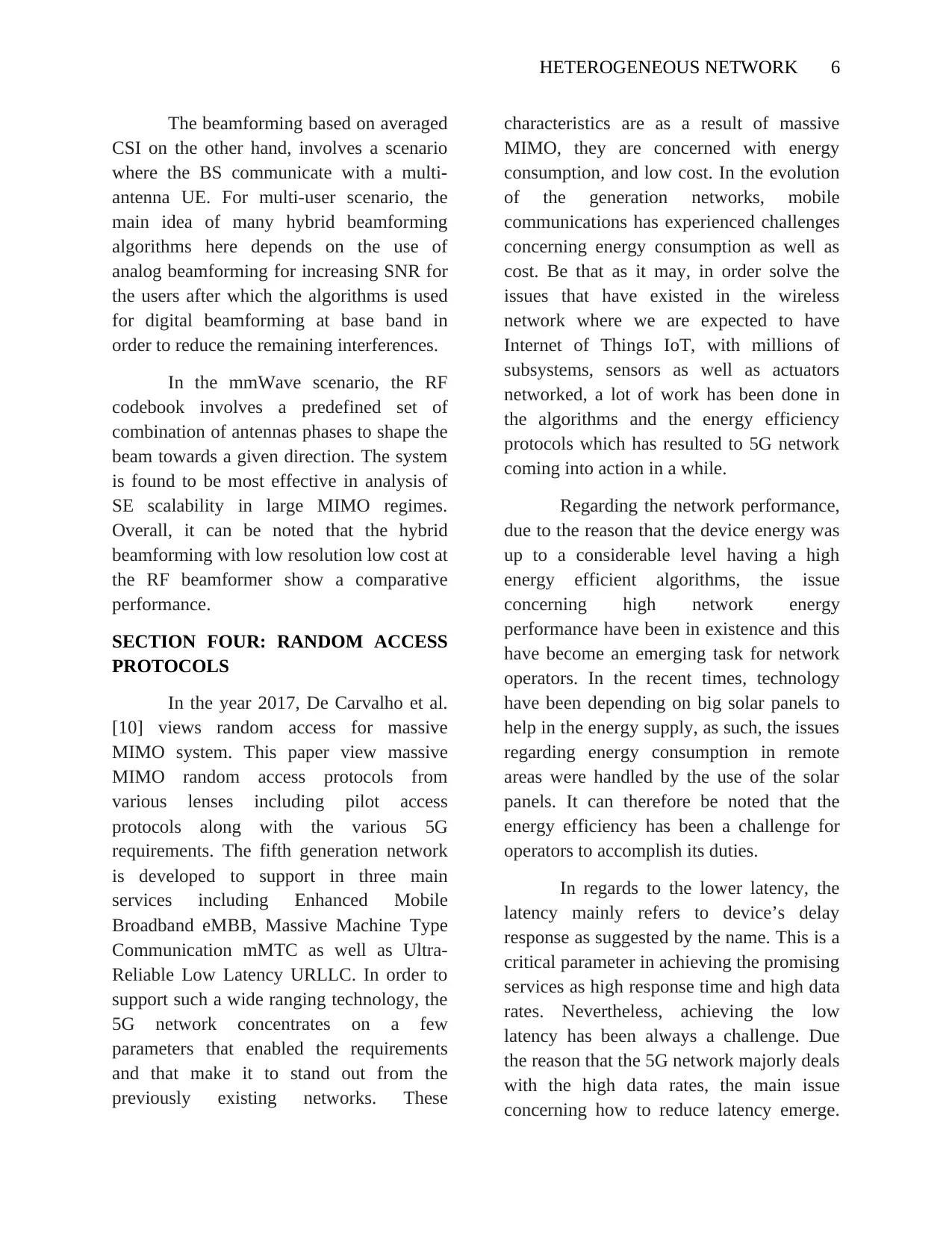
HETEROGENEOUS NETWORK 6
The beamforming based on averaged
CSI on the other hand, involves a scenario
where the BS communicate with a multi-
antenna UE. For multi-user scenario, the
main idea of many hybrid beamforming
algorithms here depends on the use of
analog beamforming for increasing SNR for
the users after which the algorithms is used
for digital beamforming at base band in
order to reduce the remaining interferences.
In the mmWave scenario, the RF
codebook involves a predefined set of
combination of antennas phases to shape the
beam towards a given direction. The system
is found to be most effective in analysis of
SE scalability in large MIMO regimes.
Overall, it can be noted that the hybrid
beamforming with low resolution low cost at
the RF beamformer show a comparative
performance.
SECTION FOUR: RANDOM ACCESS
PROTOCOLS
In the year 2017, De Carvalho et al.
[10] views random access for massive
MIMO system. This paper view massive
MIMO random access protocols from
various lenses including pilot access
protocols along with the various 5G
requirements. The fifth generation network
is developed to support in three main
services including Enhanced Mobile
Broadband eMBB, Massive Machine Type
Communication mMTC as well as Ultra-
Reliable Low Latency URLLC. In order to
support such a wide ranging technology, the
5G network concentrates on a few
parameters that enabled the requirements
and that make it to stand out from the
previously existing networks. These
characteristics are as a result of massive
MIMO, they are concerned with energy
consumption, and low cost. In the evolution
of the generation networks, mobile
communications has experienced challenges
concerning energy consumption as well as
cost. Be that as it may, in order solve the
issues that have existed in the wireless
network where we are expected to have
Internet of Things IoT, with millions of
subsystems, sensors as well as actuators
networked, a lot of work has been done in
the algorithms and the energy efficiency
protocols which has resulted to 5G network
coming into action in a while.
Regarding the network performance,
due to the reason that the device energy was
up to a considerable level having a high
energy efficient algorithms, the issue
concerning high network energy
performance have been in existence and this
have become an emerging task for network
operators. In the recent times, technology
have been depending on big solar panels to
help in the energy supply, as such, the issues
regarding energy consumption in remote
areas were handled by the use of the solar
panels. It can therefore be noted that the
energy efficiency has been a challenge for
operators to accomplish its duties.
In regards to the lower latency, the
latency mainly refers to device’s delay
response as suggested by the name. This is a
critical parameter in achieving the promising
services as high response time and high data
rates. Nevertheless, achieving the low
latency has been always a challenge. Due
the reason that the 5G network majorly deals
with the high data rates, the main issue
concerning how to reduce latency emerge.
The beamforming based on averaged
CSI on the other hand, involves a scenario
where the BS communicate with a multi-
antenna UE. For multi-user scenario, the
main idea of many hybrid beamforming
algorithms here depends on the use of
analog beamforming for increasing SNR for
the users after which the algorithms is used
for digital beamforming at base band in
order to reduce the remaining interferences.
In the mmWave scenario, the RF
codebook involves a predefined set of
combination of antennas phases to shape the
beam towards a given direction. The system
is found to be most effective in analysis of
SE scalability in large MIMO regimes.
Overall, it can be noted that the hybrid
beamforming with low resolution low cost at
the RF beamformer show a comparative
performance.
SECTION FOUR: RANDOM ACCESS
PROTOCOLS
In the year 2017, De Carvalho et al.
[10] views random access for massive
MIMO system. This paper view massive
MIMO random access protocols from
various lenses including pilot access
protocols along with the various 5G
requirements. The fifth generation network
is developed to support in three main
services including Enhanced Mobile
Broadband eMBB, Massive Machine Type
Communication mMTC as well as Ultra-
Reliable Low Latency URLLC. In order to
support such a wide ranging technology, the
5G network concentrates on a few
parameters that enabled the requirements
and that make it to stand out from the
previously existing networks. These
characteristics are as a result of massive
MIMO, they are concerned with energy
consumption, and low cost. In the evolution
of the generation networks, mobile
communications has experienced challenges
concerning energy consumption as well as
cost. Be that as it may, in order solve the
issues that have existed in the wireless
network where we are expected to have
Internet of Things IoT, with millions of
subsystems, sensors as well as actuators
networked, a lot of work has been done in
the algorithms and the energy efficiency
protocols which has resulted to 5G network
coming into action in a while.
Regarding the network performance,
due to the reason that the device energy was
up to a considerable level having a high
energy efficient algorithms, the issue
concerning high network energy
performance have been in existence and this
have become an emerging task for network
operators. In the recent times, technology
have been depending on big solar panels to
help in the energy supply, as such, the issues
regarding energy consumption in remote
areas were handled by the use of the solar
panels. It can therefore be noted that the
energy efficiency has been a challenge for
operators to accomplish its duties.
In regards to the lower latency, the
latency mainly refers to device’s delay
response as suggested by the name. This is a
critical parameter in achieving the promising
services as high response time and high data
rates. Nevertheless, achieving the low
latency has been always a challenge. Due
the reason that the 5G network majorly deals
with the high data rates, the main issue
concerning how to reduce latency emerge.
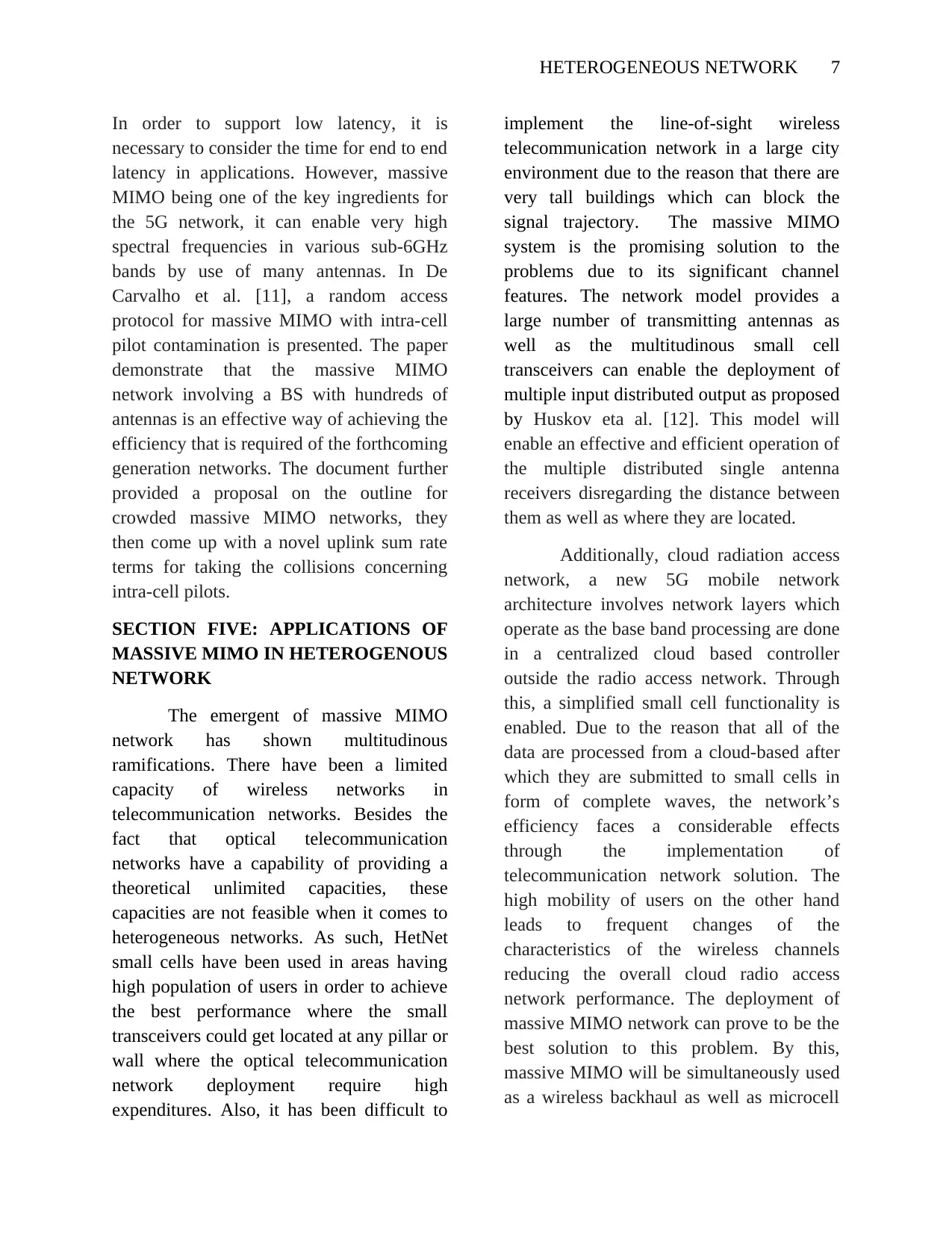
HETEROGENEOUS NETWORK 7
In order to support low latency, it is
necessary to consider the time for end to end
latency in applications. However, massive
MIMO being one of the key ingredients for
the 5G network, it can enable very high
spectral frequencies in various sub-6GHz
bands by use of many antennas. In De
Carvalho et al. [11], a random access
protocol for massive MIMO with intra-cell
pilot contamination is presented. The paper
demonstrate that the massive MIMO
network involving a BS with hundreds of
antennas is an effective way of achieving the
efficiency that is required of the forthcoming
generation networks. The document further
provided a proposal on the outline for
crowded massive MIMO networks, they
then come up with a novel uplink sum rate
terms for taking the collisions concerning
intra-cell pilots.
SECTION FIVE: APPLICATIONS OF
MASSIVE MIMO IN HETEROGENOUS
NETWORK
The emergent of massive MIMO
network has shown multitudinous
ramifications. There have been a limited
capacity of wireless networks in
telecommunication networks. Besides the
fact that optical telecommunication
networks have a capability of providing a
theoretical unlimited capacities, these
capacities are not feasible when it comes to
heterogeneous networks. As such, HetNet
small cells have been used in areas having
high population of users in order to achieve
the best performance where the small
transceivers could get located at any pillar or
wall where the optical telecommunication
network deployment require high
expenditures. Also, it has been difficult to
implement the line-of-sight wireless
telecommunication network in a large city
environment due to the reason that there are
very tall buildings which can block the
signal trajectory. The massive MIMO
system is the promising solution to the
problems due to its significant channel
features. The network model provides a
large number of transmitting antennas as
well as the multitudinous small cell
transceivers can enable the deployment of
multiple input distributed output as proposed
by Huskov eta al. [12]. This model will
enable an effective and efficient operation of
the multiple distributed single antenna
receivers disregarding the distance between
them as well as where they are located.
Additionally, cloud radiation access
network, a new 5G mobile network
architecture involves network layers which
operate as the base band processing are done
in a centralized cloud based controller
outside the radio access network. Through
this, a simplified small cell functionality is
enabled. Due to the reason that all of the
data are processed from a cloud-based after
which they are submitted to small cells in
form of complete waves, the network’s
efficiency faces a considerable effects
through the implementation of
telecommunication network solution. The
high mobility of users on the other hand
leads to frequent changes of the
characteristics of the wireless channels
reducing the overall cloud radio access
network performance. The deployment of
massive MIMO network can prove to be the
best solution to this problem. By this,
massive MIMO will be simultaneously used
as a wireless backhaul as well as microcell
In order to support low latency, it is
necessary to consider the time for end to end
latency in applications. However, massive
MIMO being one of the key ingredients for
the 5G network, it can enable very high
spectral frequencies in various sub-6GHz
bands by use of many antennas. In De
Carvalho et al. [11], a random access
protocol for massive MIMO with intra-cell
pilot contamination is presented. The paper
demonstrate that the massive MIMO
network involving a BS with hundreds of
antennas is an effective way of achieving the
efficiency that is required of the forthcoming
generation networks. The document further
provided a proposal on the outline for
crowded massive MIMO networks, they
then come up with a novel uplink sum rate
terms for taking the collisions concerning
intra-cell pilots.
SECTION FIVE: APPLICATIONS OF
MASSIVE MIMO IN HETEROGENOUS
NETWORK
The emergent of massive MIMO
network has shown multitudinous
ramifications. There have been a limited
capacity of wireless networks in
telecommunication networks. Besides the
fact that optical telecommunication
networks have a capability of providing a
theoretical unlimited capacities, these
capacities are not feasible when it comes to
heterogeneous networks. As such, HetNet
small cells have been used in areas having
high population of users in order to achieve
the best performance where the small
transceivers could get located at any pillar or
wall where the optical telecommunication
network deployment require high
expenditures. Also, it has been difficult to
implement the line-of-sight wireless
telecommunication network in a large city
environment due to the reason that there are
very tall buildings which can block the
signal trajectory. The massive MIMO
system is the promising solution to the
problems due to its significant channel
features. The network model provides a
large number of transmitting antennas as
well as the multitudinous small cell
transceivers can enable the deployment of
multiple input distributed output as proposed
by Huskov eta al. [12]. This model will
enable an effective and efficient operation of
the multiple distributed single antenna
receivers disregarding the distance between
them as well as where they are located.
Additionally, cloud radiation access
network, a new 5G mobile network
architecture involves network layers which
operate as the base band processing are done
in a centralized cloud based controller
outside the radio access network. Through
this, a simplified small cell functionality is
enabled. Due to the reason that all of the
data are processed from a cloud-based after
which they are submitted to small cells in
form of complete waves, the network’s
efficiency faces a considerable effects
through the implementation of
telecommunication network solution. The
high mobility of users on the other hand
leads to frequent changes of the
characteristics of the wireless channels
reducing the overall cloud radio access
network performance. The deployment of
massive MIMO network can prove to be the
best solution to this problem. By this,
massive MIMO will be simultaneously used
as a wireless backhaul as well as microcell
Paraphrase This Document
Need a fresh take? Get an instant paraphrase of this document with our AI Paraphraser
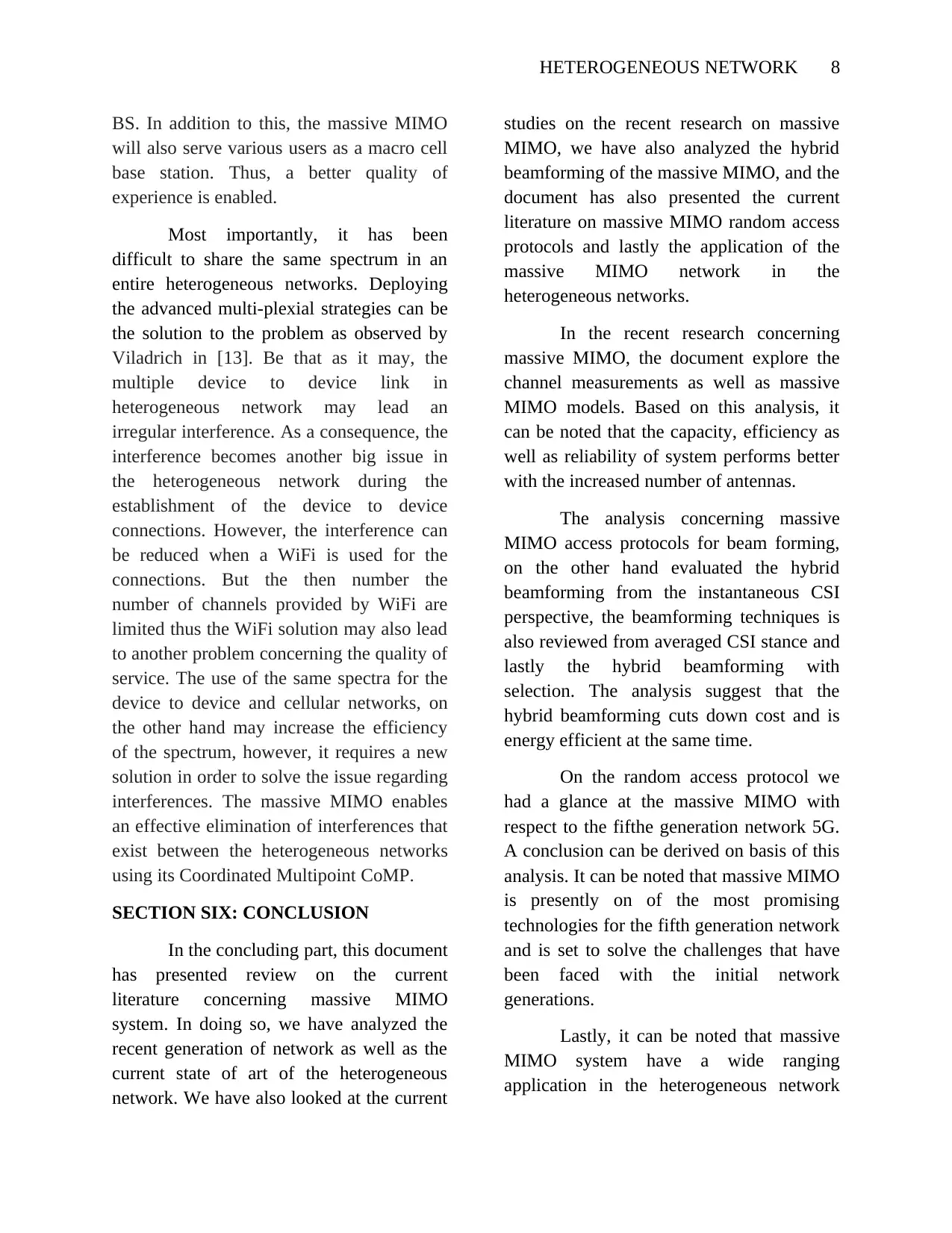
HETEROGENEOUS NETWORK 8
BS. In addition to this, the massive MIMO
will also serve various users as a macro cell
base station. Thus, a better quality of
experience is enabled.
Most importantly, it has been
difficult to share the same spectrum in an
entire heterogeneous networks. Deploying
the advanced multi-plexial strategies can be
the solution to the problem as observed by
Viladrich in [13]. Be that as it may, the
multiple device to device link in
heterogeneous network may lead an
irregular interference. As a consequence, the
interference becomes another big issue in
the heterogeneous network during the
establishment of the device to device
connections. However, the interference can
be reduced when a WiFi is used for the
connections. But the then number the
number of channels provided by WiFi are
limited thus the WiFi solution may also lead
to another problem concerning the quality of
service. The use of the same spectra for the
device to device and cellular networks, on
the other hand may increase the efficiency
of the spectrum, however, it requires a new
solution in order to solve the issue regarding
interferences. The massive MIMO enables
an effective elimination of interferences that
exist between the heterogeneous networks
using its Coordinated Multipoint CoMP.
SECTION SIX: CONCLUSION
In the concluding part, this document
has presented review on the current
literature concerning massive MIMO
system. In doing so, we have analyzed the
recent generation of network as well as the
current state of art of the heterogeneous
network. We have also looked at the current
studies on the recent research on massive
MIMO, we have also analyzed the hybrid
beamforming of the massive MIMO, and the
document has also presented the current
literature on massive MIMO random access
protocols and lastly the application of the
massive MIMO network in the
heterogeneous networks.
In the recent research concerning
massive MIMO, the document explore the
channel measurements as well as massive
MIMO models. Based on this analysis, it
can be noted that the capacity, efficiency as
well as reliability of system performs better
with the increased number of antennas.
The analysis concerning massive
MIMO access protocols for beam forming,
on the other hand evaluated the hybrid
beamforming from the instantaneous CSI
perspective, the beamforming techniques is
also reviewed from averaged CSI stance and
lastly the hybrid beamforming with
selection. The analysis suggest that the
hybrid beamforming cuts down cost and is
energy efficient at the same time.
On the random access protocol we
had a glance at the massive MIMO with
respect to the fifthe generation network 5G.
A conclusion can be derived on basis of this
analysis. It can be noted that massive MIMO
is presently on of the most promising
technologies for the fifth generation network
and is set to solve the challenges that have
been faced with the initial network
generations.
Lastly, it can be noted that massive
MIMO system have a wide ranging
application in the heterogeneous network
BS. In addition to this, the massive MIMO
will also serve various users as a macro cell
base station. Thus, a better quality of
experience is enabled.
Most importantly, it has been
difficult to share the same spectrum in an
entire heterogeneous networks. Deploying
the advanced multi-plexial strategies can be
the solution to the problem as observed by
Viladrich in [13]. Be that as it may, the
multiple device to device link in
heterogeneous network may lead an
irregular interference. As a consequence, the
interference becomes another big issue in
the heterogeneous network during the
establishment of the device to device
connections. However, the interference can
be reduced when a WiFi is used for the
connections. But the then number the
number of channels provided by WiFi are
limited thus the WiFi solution may also lead
to another problem concerning the quality of
service. The use of the same spectra for the
device to device and cellular networks, on
the other hand may increase the efficiency
of the spectrum, however, it requires a new
solution in order to solve the issue regarding
interferences. The massive MIMO enables
an effective elimination of interferences that
exist between the heterogeneous networks
using its Coordinated Multipoint CoMP.
SECTION SIX: CONCLUSION
In the concluding part, this document
has presented review on the current
literature concerning massive MIMO
system. In doing so, we have analyzed the
recent generation of network as well as the
current state of art of the heterogeneous
network. We have also looked at the current
studies on the recent research on massive
MIMO, we have also analyzed the hybrid
beamforming of the massive MIMO, and the
document has also presented the current
literature on massive MIMO random access
protocols and lastly the application of the
massive MIMO network in the
heterogeneous networks.
In the recent research concerning
massive MIMO, the document explore the
channel measurements as well as massive
MIMO models. Based on this analysis, it
can be noted that the capacity, efficiency as
well as reliability of system performs better
with the increased number of antennas.
The analysis concerning massive
MIMO access protocols for beam forming,
on the other hand evaluated the hybrid
beamforming from the instantaneous CSI
perspective, the beamforming techniques is
also reviewed from averaged CSI stance and
lastly the hybrid beamforming with
selection. The analysis suggest that the
hybrid beamforming cuts down cost and is
energy efficient at the same time.
On the random access protocol we
had a glance at the massive MIMO with
respect to the fifthe generation network 5G.
A conclusion can be derived on basis of this
analysis. It can be noted that massive MIMO
is presently on of the most promising
technologies for the fifth generation network
and is set to solve the challenges that have
been faced with the initial network
generations.
Lastly, it can be noted that massive
MIMO system have a wide ranging
application in the heterogeneous network

HETEROGENEOUS NETWORK 9
ranging from line-of-sight wireless
telecommunication network deployment to
elimination of interferences in the networks.
REFERENCES
[1] M. Alageli, A. Ikhlef, J. Chambers. SWIPT
massive MIMO systems with active eavesdropping.
IEEE Journal on Selected Areas in Communications.
2019 Jan;37(1):233-47.
[2] T. Bogale, B. Le. Massive MIMO and mmWave
for 5G wireless HetNet: Potential benefits and
challenges. IEEE Vehicular Technology Magazine.
2016 Mar;11(1):64-75.
[3] P. Zhang, J. Chen, X. Yang, N. Ma, Z. Zhang.
Recent Research on Massive MIMO Propagation
Channels: A Survey. IEEE Communications
Magazine. 2018 Dec;56(12):22-9.
[4] Y. Yu, J. Zhang, M. Shafi, P. Dmochowski, M.
Zhang, J. Mirza. Measurements of 3D channel
impulse response for outdoor-to-indoor scenario:
Capacity predictions for different antenna arrays.
In2015 IEEE 26th Annual International Symposium
on Personal, Indoor, and Mobile Radio
Communications (PIMRC) 2015 Aug 30 (pp. 408-
413). IEEE.
[5] J. Flordelis, X. Gao, G. Dahman, F. Rusek, O.
Edfors, F. Tufvesson. Spatial separation of closely-
spaced users in measured multi-user massive MIMO
channels. In2015 IEEE International Conference on
Communications (ICC) 2015 Jun.
[6] L. Liu, W. Matolak, C. Tao, Y. Lu, B. Ai, H.
Chen. Geometry based large scale attenuation over
linear massive MIMO systems. In2016 10th
European Conference on Antennas and Propagation
(EuCAP) 2016 Apr 10 (pp. 1-5). IEEE.
[7] A. Kammoun, M. Debbah, S. Alouini. On the
mutual information of 3D massive MIMO systems:
An asymptotic approach. In2015 IEEE International
Symposium on Information Theory (ISIT) 2015 Jun
14 (pp. 2588-2592). IEEE.
[8] F. Molisch, V. Ratnan, S. Han, Z. Li, S. Nguyen,
L. Li, K. Haneda. Hybrid beamforming for massive
MIMO: A survey. IEEE Communications Magazine.
2017;55(9):134-41.
[9] J. Singh, S. Ramakrishna. On the feasibility of
codebook-based beamforming in millimeter wave
systems with multiple antenna arrays. IEEE
transactions on Wireless Communications. 2015
May;14(5):2670-83.
[10] E. De Carvalho, E. Bjornson, J. Sorensen, P.
Popovski, E. Larsson. Random access protocols for
massive MIMO. IEEE Communications Magazine.
2017 May;55(5):216-22.
[11] E. De Carvalho, E. Björnson, G. Larsson, P.
Popovski. Random access for massive MIMO
systems with intra-cell pilot contamination. In2016
IEEE International Conference on Acoustics, Speech
and Signal Processing (ICASSP) 2016 Mar 20 (pp.
3361-3365). IEEE.
[12] P. Huskov, T. Maksymyuk, I. Kahalo, M.
Klymash. Smart backhauling subsystem for 5G
heterogeneous network. InThe Experience of
Designing and Application of CAD Systems in
Microelectronics 2015 Feb 24 (pp. 481-483). IEEE.
[13] A. Viladrich. More than two to tango: Argentine
tango immigrants in New York City. University of
Arizona Press; 2013 Sep 26.
ranging from line-of-sight wireless
telecommunication network deployment to
elimination of interferences in the networks.
REFERENCES
[1] M. Alageli, A. Ikhlef, J. Chambers. SWIPT
massive MIMO systems with active eavesdropping.
IEEE Journal on Selected Areas in Communications.
2019 Jan;37(1):233-47.
[2] T. Bogale, B. Le. Massive MIMO and mmWave
for 5G wireless HetNet: Potential benefits and
challenges. IEEE Vehicular Technology Magazine.
2016 Mar;11(1):64-75.
[3] P. Zhang, J. Chen, X. Yang, N. Ma, Z. Zhang.
Recent Research on Massive MIMO Propagation
Channels: A Survey. IEEE Communications
Magazine. 2018 Dec;56(12):22-9.
[4] Y. Yu, J. Zhang, M. Shafi, P. Dmochowski, M.
Zhang, J. Mirza. Measurements of 3D channel
impulse response for outdoor-to-indoor scenario:
Capacity predictions for different antenna arrays.
In2015 IEEE 26th Annual International Symposium
on Personal, Indoor, and Mobile Radio
Communications (PIMRC) 2015 Aug 30 (pp. 408-
413). IEEE.
[5] J. Flordelis, X. Gao, G. Dahman, F. Rusek, O.
Edfors, F. Tufvesson. Spatial separation of closely-
spaced users in measured multi-user massive MIMO
channels. In2015 IEEE International Conference on
Communications (ICC) 2015 Jun.
[6] L. Liu, W. Matolak, C. Tao, Y. Lu, B. Ai, H.
Chen. Geometry based large scale attenuation over
linear massive MIMO systems. In2016 10th
European Conference on Antennas and Propagation
(EuCAP) 2016 Apr 10 (pp. 1-5). IEEE.
[7] A. Kammoun, M. Debbah, S. Alouini. On the
mutual information of 3D massive MIMO systems:
An asymptotic approach. In2015 IEEE International
Symposium on Information Theory (ISIT) 2015 Jun
14 (pp. 2588-2592). IEEE.
[8] F. Molisch, V. Ratnan, S. Han, Z. Li, S. Nguyen,
L. Li, K. Haneda. Hybrid beamforming for massive
MIMO: A survey. IEEE Communications Magazine.
2017;55(9):134-41.
[9] J. Singh, S. Ramakrishna. On the feasibility of
codebook-based beamforming in millimeter wave
systems with multiple antenna arrays. IEEE
transactions on Wireless Communications. 2015
May;14(5):2670-83.
[10] E. De Carvalho, E. Bjornson, J. Sorensen, P.
Popovski, E. Larsson. Random access protocols for
massive MIMO. IEEE Communications Magazine.
2017 May;55(5):216-22.
[11] E. De Carvalho, E. Björnson, G. Larsson, P.
Popovski. Random access for massive MIMO
systems with intra-cell pilot contamination. In2016
IEEE International Conference on Acoustics, Speech
and Signal Processing (ICASSP) 2016 Mar 20 (pp.
3361-3365). IEEE.
[12] P. Huskov, T. Maksymyuk, I. Kahalo, M.
Klymash. Smart backhauling subsystem for 5G
heterogeneous network. InThe Experience of
Designing and Application of CAD Systems in
Microelectronics 2015 Feb 24 (pp. 481-483). IEEE.
[13] A. Viladrich. More than two to tango: Argentine
tango immigrants in New York City. University of
Arizona Press; 2013 Sep 26.
1 out of 9
Related Documents
Your All-in-One AI-Powered Toolkit for Academic Success.
+13062052269
info@desklib.com
Available 24*7 on WhatsApp / Email
![[object Object]](/_next/static/media/star-bottom.7253800d.svg)
Unlock your academic potential
© 2024 | Zucol Services PVT LTD | All rights reserved.





